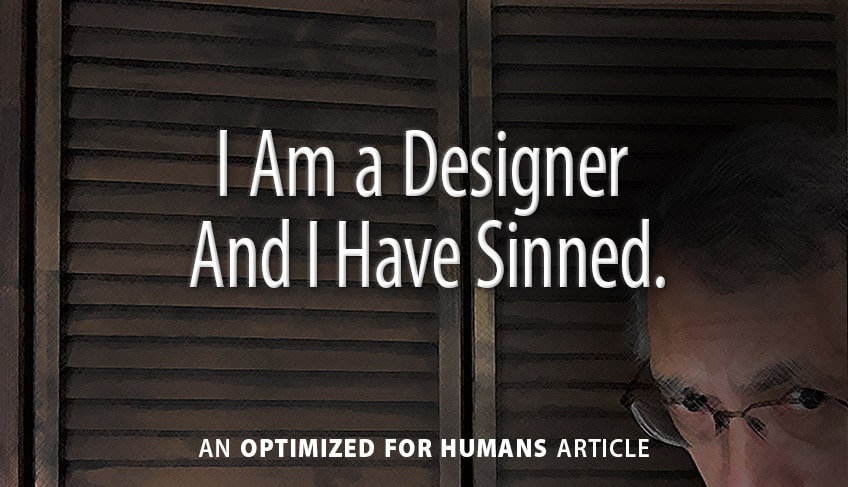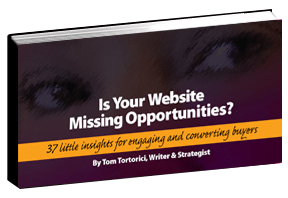
B Y T O M T O R T O R I C I
It’s true. I look back with cringing regret at some of the things I did when first starting out as an advertising designer.
Then, as you’ll see, I began seeing things from the audience’s point-of-view, rather than just from a design perspective. That led to creating headlines and text to accompany my own designs.
Now that I mostly write strategic marketing copy for a living, I know lots of things that didn’t occur to me as a young designer. In fact, I’m sort of embarrassed at once having used my client’s budget as my own personal creative canvas, rather than a strategic attempt to turn their readers into buyers.
What did I do then, that makes me cringe now? A number of things, I suppose.
I thought design was everything.
I spent a lot of billable hours poring over images, colors, fonts and arrangements that seemed creative or edgy. Not that visuals or design are unimportant, of course. But truth be told, I wasn’t thinking about how actual buyers would react. If anything, I was thinking about whether my fellow designers would approve. I was experimenting, trying to please myself, because after all, wasn’t my job to be ‘creative’?
I put cleverness above clarity.
I know, I should have known better. But I was young, and was trying to copy the type of ‘creative concepts’ that seemed to be winning industry awards. What I didn’t realize was that those award-winning agencies were often soon fired by the client. Why? Because sales were flat. Why? Because the creatives had put cleverness above clarity. Even if consumers were momentarily entertained, they didn’t clearly remember the product. Epic fail.
I minimized the importance of the copy.
I made the text fairly tiny, so my design would look more pristine. I stuck it in the corner, so the focus would be on that huge photo that I loved. I placed it over a big complicated background without enough contrast because, well, it was just a design element to me. I created ads and other pieces that were meant to be looked at, not read. What escaped me was that if buyers didn’t read about the product’s benefits, they had no reason to buy the product.
I had ignored my own sensibilities as a buyer.
But then something happened that changed my perspective forever. Over lunch one day, I had flipped the page of a magazine, to an ad of something I happened to be in the market for. Then I flipped to the next page. Wait a minute. Go back. Why didn’t I even bother to read that ad?
Looking more carefully through the ‘eyes’ of an actual buyer, I noticed a number of issues that made the ad attractive, but otherwise easy to ignore by real-world consumers. The nauseating, skin-crawling hot flash came when I realized they were the same mistakes I had been making in my own advertising layouts.
The problem? All along, I had been trying to get the reader to fall in love with my ad design, not with my client’s product.
I carried that lesson with me as I transitioned to digital media, where the same principles apply. I’ve learned that unless you’re painting cityscapes on the streets of Paris, it’s not about creativity for its own sake. It’s about using words, visuals and strategy to connect the buyer’s problem with the seller’s solution.
Anyway, now that I’ve confessed, I can say that I’m truly sorry for my past sins, and for the paying clients who trusted me to act in their best interest.
As part of my penance, I’ve tried to use my copywriting classes, my meetup and conference talks, my e-books, my social media posts, and this very blog to help others avoid the transgressions I was once guilty of. If I’ve helped at least one other creative professional to look at their work “through the buyer’s eyes,” well, I guess I’ll count that as redemption.
Sign up for the free e-book in the sidebar, to quickly learn some of the things it took me years to understand.
Share It:
 About the Author: Tom Tortorici is an Atlanta copywriter and web content writer who helps companies make a genuine connection with their audience. His classes and conference presentations have focused on how writing, strategy and design can work together to grab attention and interest even among readers with short attention spans. In addition to working directly with businesses, Tom regularly partners with web designers and marketing agencies.
About the Author: Tom Tortorici is an Atlanta copywriter and web content writer who helps companies make a genuine connection with their audience. His classes and conference presentations have focused on how writing, strategy and design can work together to grab attention and interest even among readers with short attention spans. In addition to working directly with businesses, Tom regularly partners with web designers and marketing agencies.
All Posts/Subscribe >
Info for Businesses >
Info for Designers/Agencies >
Tom Tortorici Inc. | Tom@TomTortorici.com | 770-934-7861 | 3101 Rockaway Rd | Atlanta GA 30341

